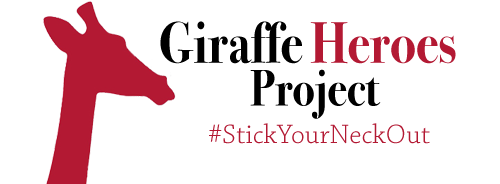Giraffe Program evaluation in WA State
March-September 2009
Assessments Results
I. From 150 pre- and post-use student questionnaires collected in the course of the program in classrooms and summer programs from March through September, 2009. students were mostly elementary-age.
1. Student perceptions of what is a “hero”
Before use of the Giraffe Heroes Program (GHP), student perceptions of what is a “hero” centered very strongly on cartoon superheroes such as Batman. After listening and reading stories of the “Giraffe Heroes” that are central to the GHP, the students perceptions shifted significantly to “people who help others,” with examples being: my mom, my pastor, doctors, firefighters, my uncle because he fought in the army, Dr. Marin Luther King, Cesar Chavez and Eleanor Roosevelt.
Tracking the above shift, student descriptions of the qualities that heroes possess shifted from the exaggerated qualities of superheroes to appreciation of the qualities of real-world heroes such as helping others, helping the planet, being a good role model, and being good, persistence courageous and caring.
2. Where might students stick their own necks out to be heroes?
Comments ranged from the general to the specific: finding a need and filling it, fighting against drugs, saving the world, helping a lady across the street, helping other people, recycling, and “helping my aunt Sherrie stop smoking.” Problems of concern to students included: smoking, bullying, littering, drugs, polluting and wasting energy.
3. What did students learn about themselves in the GHP?
Comments centered on recognizing and strengthening personal skills such as being nice, not to be afraid of anything, being a human Giraffe, being a hero, “stepping out and doing things,” and being more thoughtful and caring.
4. What students say they will do with what they have learned in the GHP.
Again, comments ranged from the general to the specific: “keeping the lake clean,” helping the world, stopping littering, helping the homeless, planting more trees, recycling, patrolling for bullies, cleaning up, and “turning off the water while I brush.”
5. What students liked most about the GHP:
Illustrative comments:
I liked the Giraffe program because I learned about people doing things that I never thought people would do.”
“It’s fun to learn how to make change.”
“The program inspired me to go out and see if I could help people or the world.”
“It made me feel like I want to do something like that when I get older.”
6. Statistical changes
Following the GHP, averaging all results on a scale of 1 (“strongly agree”) to 5 (“strongly disagree”), students thought:
“There is nothing one person can do to solve big problems:” 4.0
“It’s my responsibility to help solve problems:” 2.0
“I can make a difference on these problems:” 1.7
II. From 8 teacher/facilitator assessments:
1. Were you pleased?
- “Absolutely.”
- “The program is wonderful and I loved teaching it. The students loved the stories.”
- “I can’t wait to use it with middle school students.”
- “The students really loved working on this and they were amazed at some of the heroes stories.”
- “The students loved working on this project. The lessons were easy to follow and very helpful.”
- “Overall this was an awesome project.”
2. Did you notice improvements in your student’s ability to reason and to solve problems as a result of working on this project?
- “Students worked together better as a team.”
- “They are nicer to each other.”
- “It made my students more aware of problems in the world (we live in a small community where kids don’t see or hear much about homelessness, for example).”
- “My students learned you can be a hero even when you are young.”
- “More participation in class activities.”
- “I saw real demonstrations of Giraffe qualities—students are taking more awareness in their actions and behavior toward other, for example, coming to the aid of someone hurt during recess.”
- “There were changes in student’s awareness, definition and appreciation of heroes.”
